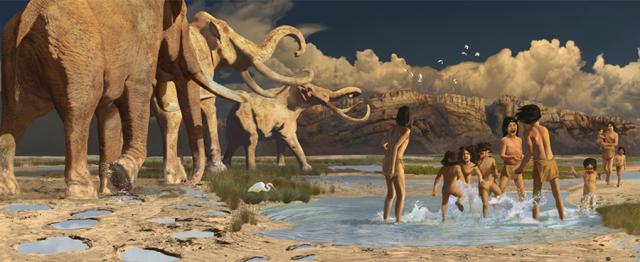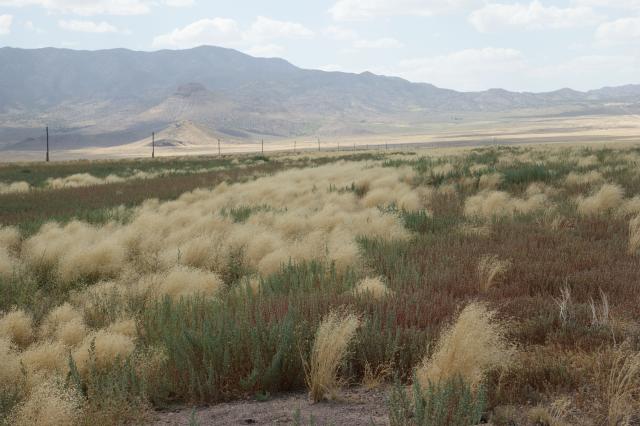You are viewing ARCHIVED content published online before January 20, 2025. Please note that this content is NOT UPDATED, and links may not work. Additionally, any previously issued diversity, equity, inclusion or gender-related guidance on this webpage should be considered rescinded. For current information, visit https://www.blm.gov/blog.
Native American storytelling brings our living lands to life
This Native American Heritage Month, we celebrate the rich perspectives that Native Americans bring to land management.
As North America’s earliest inhabitants, Native Americans have a powerful connection to the land they’ve lived on for thousands of years. Tribes pass down deep memories of ancient times through the generations by telling stories that use vivid language to describe a living landscape with a rich creation story. A landscape their people interact with and cherish as part of an intricate and delicate balance.
For example, as quoted in a recent research paper,2 one Southern Paiute Tribal elder said:
A lot of the things that were placed there were put here for a reason so all the different rocks and things that you see, everything that’s out in this landscape, including all the geology, is very much alive. It is things that we use, we rely upon; it talks to us, we talk to it.
Although scientific understandings during the past 75 years generally state that Native people occupied North America no longer than 12,000 years ago, as the research paper notes,2 there are “recent science findings that Native people were present in North America up to 40,000 years ago. Opening the science limits of Native presence affords a reinterpretation of the past using extant Native interpretations.”
As a result, another recent research paper1 states that: “federal agencies are beginning to recognize the presence of Native people in these Pleistocene ecosystems.”

So, what value does Tribal oral history add to federal land management?
Richard Stoffle is a Professor of Anthropology at the University of Arizona. As part of his job, he serves as an independent researcher producing neutral assessments to benefit communities impacted by major development projects. Those communities include some U.S. Department of the Interior Bureau of Land Management projects.
Stoffle has worked with BLM employees during the last four decades on two dozen Environmental Impact Statement research projects. BLM carries out these environmental analyses to understand and document the impacts of any "major federal action significantly affecting the quality of the human environment" (NEPA Sec. 102(C)).3
Tribes hold an important role in this process.
“Native Americans are involved in [environmental] studies because they are traditionally connected with potentially impacted lands,” Stoffle notes.
BLM has a vital mandate to incorporate Indigenous Knowledge and values into land management. As such, the agency routinely conducts Tribal consultation on major projects.
One of these recent projects was BLM’s Solar Energy Programmatic Environmental Impact Statement, also known as the Western Solar Plan. BLM stated its commitment to engaging Tribal Nations in a meaningful and respectful manner throughout the process of updating the Western Solar Plan. Recognizing the importance of early and continued collaboration, in December 2022 – as the effort got underway – BLM reached out to 241 Tribal Nations, chapters, and bands to build awareness and invite their participation. BLM maintained engagement with Tribes throughout the effort to gain and incorporate Indigenous perspectives and traditional knowledge, ensuring Tribal voices are meaningfully included in the planning process.
In January 2024, BLM continued its commitment by engaging 248 Tribal Nations through an informational webinar to present a draft version of the environmental analysis, gather valuable insights, and respond to questions. By August 2024, 22 Tribal Nations had provided input, expressed concerns, requested further information, or sought consultation. Seventeen Tribal Nations, including one not federally recognized, requested consultations, while one Nation withdrew its request after reviewing the materials.
BLM has conducted five Government-to-Government consultations as of August 2024 and remains dedicated to ongoing, respectful engagement with all Tribal Nations to ensure their voices, knowledge, and perspectives are meaningfully included in the planning process. In fact, the BLM most recently held continued Government-to-Government consultation with two Tribes in California regarding the Western Solar Plan.
In addition, since Tribes are known to attach religious and cultural significance to historic properties that could be affected by the solar development, BLM invested substantial funding to support cultural landscape studies to help identify and better understand the impacts of agency decisions on Tribal ancestral lands and other significant landscapes that BLM administers and continues to see substantial development interest.
During fieldwork, Tribal representatives expressed deep knowledge of the now largely dry playas, which represented a time when large lakes and wetlands filled the valleys and were the central homes of Native American peoples. Cultural continuity back to the Pleistocene was expressed in each [environmental] study.
The paper1 also states that:
The involved American Indian tribal governments and their appointed cultural representatives participated in the Solar [environmental analysis process] to explain the meaning and cultural centrality of the plants, animals, spiritual trails, healing places, and places of historic encounters that exist in these playa lands.

Stoffle also conducted research on the relationship between Native Americans and aboriginal natural resources. He recently gave a talk at the Society for Applied Anthropology’s annual meeting on the role of Native American cultural issues in environmental impact studies, titled “A National Reckoning: Native Americans’ Environmental Justice Expanded in Scope and Time.”
As we look to the future of our public lands, it is important to consider the Native American experience and to continue to incorporate Native American voices into land management practices. And what better way to do this than to examine the past through the lens of the earliest caretakers of what is today our shared public lands.
1 “Cultural Meaning of Playas to Native Americans.” Richard W Stoffle, Kathleen A. Van Vlack, Bianca Eguino Uribe, Alannah Bell, Landon Yarrington, and Heather H. Lim. May 18, 2024. GEMS Journal.
2 “Breaking the Clovis glass ceiling: Native American oral history of the Pleistocene.” Richard W. Stoffle, Kathleen A. Van Vlack, Heather H. Lim, Alannah Bell, and Landon Yarrington. June 18, 2024. AIMS Geosciences, 10(3): 436–459.
3 "NATIONAL ENVIRONMENTAL POLICY ACT OF 1969." Retrieved from: https://www.govinfo.gov/content/pkg/COMPS-10352/pdf/COMPS-10352.pdf
Meredith Black, public affairs specialist
Related Stories
- Using science to uncover mysteries of the Mesa archaeological site in Alaska
- “Where did my horse come from?” BLM launches a new way for adopters, trainers and others to learn about their wild horses and burros
- Lake Havasu Fisheries Improvement Program is the gift that keeps giving
- BLM is thankful for public lands volunteers
- BLM Fire and National Conservation Lands managers collaborate to meet shared goals
Office
1849 C Street NW
Washington, DC 20240
United States
